Let’s Twist Again: TubeTwist
TubeTwist is great hybrid puzzle-y physics game by 21-6 Productions, best known for their Orbz title, and distributed by GarageGames. The product page describes TubeTwist as follows:
TubeTwist is a puzzle game fashioned after classics like The Incredible Machine and Mouse Trap. Each experiment has many solutions due to the large variety of tubes which can be used to construct each machine. There is no clock and there is no score – so just sit back and enjoy the mind bending fun that is TubeTwist!
It’s Thinking Time
The goal of TubeTwist is deceptively simple. Colored balls start in one tube, and it’s your job as the player to ensure they wind up in a colored end tubes. Each level has a starting layout. In addition to the default pieces, you’re given a limited number of pieces to place wherever you choose. You can use these pieces to bridge gaps in the default layout or to create your own path. I’ve actually solved levels where I don’t even touch the starting layout.
While the goal is obvious enough, the game’s complexity arises through two mechanisms: scarcity and object states.
Piece Scarcity
Some levels are difficult because of the scarcity of the pieces available to the player. You’re given a handful of tubes, at best–certainly not enough pieces to go from point A to point B continuously. These levels force you to rely on the physics of the ball. Inertia can be your friend; if the ball is going fast enough, you don’t need a contiguous pathway. Rather, you could have a few holes and the ball will zip over the gaps without any trouble. Or if you’re feeling especially spicy, you can actually try to launch a ball quite some distance into a tube (the video has an example of this). Accelerator tubes speed the ball up. Careful placement allows you to regulate the ball’s velocity with a fair degree of control, allowing for crafty gap jumps.
Object States
This is where TubeTwist shows its puzzle origins. Many of the tubes have states associated with them. Some tubes toggle their direction after a ball passes through them, while others are physics contraptions in and of themselves. Still other tubes modify the state of the ball–toggling between a gravity-free version and the normal clunky ball.
Depending on how receptive you are to feeling like a complete idiot, you may find the puzzle aspects of TubeTwist frustrating. Typically the levels force you to regulate the order in which things happen. If you need ball A to pass through a tube before ball B gets there, you’ll need to find some way to slow it down. It can get awfully hairy when later levels have upwards of half a dozen switches.
Yet More Complexity
The game also introduces checkpoints in later levels. Rather than simply get the ball from the start to the goal, you need to activate all the checkpoints first. And I did I mention that some levels have half a dozen starting points all spewing balls simultaneously? Later levels really lay on the brain-hurt awfully thick. The game forces you to manage a large number of events in a particular order to pass the stage.
Physics to the Rescue
If TubeTwist were simply a puzzle game, I probably wouldn’t play it. I’m not a big fan of logic puzzles, to be honest (maybe I’m just not very good at them). But because TubeTwist is physics-based, though, I really find myself enjoying it. The physics, coupled with the large number of tubes, means that any one level has a number of solutions available. Some of the solutions are obviously the designer’s intent, while others may be completely new.
Physics do a great job of managing the complexity of what would otherwise be a completely overwhelming puzzle game. It’s a very approachable design. You simply run the machine, note where balls are failing, and make iterative adjustments. Because everything follows the intuitive nature of physics, nothing is ever too confusing.
“PassagePeculiarity” Just Didn’t Have the Same Ring
21-6 Productions managed to use physics to great effect and produced a title that’s challenging yet approachable. I have no idea how well the game is selling, but TubeTwist has already picked up an IGF nomination and finalist status in the ECD Systems Indie Games Showcase. If you happen to be going to E3 this year, swing by booth #6453 in Kentia Hall. As a bonus, I’ll be alongside TubeTwist in the showcase demoing our next Flashbang game.
A free demo of TubeTwist is available from the GarageGames website. The full version costs $19.95.
Related Posts:
The Evolution of an Idea: Rolling Assault
Rolling Assault represents the evolution of a simple physics prototype I created a few years ago. This prototype had some merit so an artistic friend, Creath Carter, took it upon himself to create some content to the replace the lifeless polygons. We fleshed out the game a bit more in order to enter it into the IGF that year. This is the result:
Humble Beginnings
Over the summer of 2003 I spent a lot of time creating physics-based gameplay experiments. I used Virtools, our middleware of choice, and even posted all of the source code for the benefit of the Virtools developer community. The now-hibernating site was called DevLab–it’s still online, although it hasn’t been updated in awhile.
Anyway, one of the tests I created attempted to simulate the motion of a tank tread. Here is the resulting prototype, which took a few hours to create:
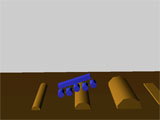
(Rolling Assault Physics Prototype 1)
The game is playable through the Virtools’ plug-in. Use the left and right arrows for control.
This was generally the scope of the prototypes I was creating at the time. The controls are there, along a first pass at balancing the motion so it “feels” pretty good. A goal structure is clearly absent, though, along with such pleasantries as a reset key (right-click and do reset through the Virtools web player if you need to).
Life’s First Creath
As bare as it was, the treads test was fun to screw around with. Creath Carter, a friend from my school days, thought the mechanic had enough potential to bestow upon it some sexy artwork. I had worked with Creath in the past and he knew his way around Virtools. It was a welcome turn of events and saved the project from being completed shelved along with the rest of the physics game experiments.
A mere six days after this first prototype, this version was posted to DevLab:
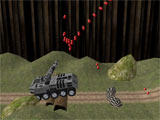
(Rolling Assault Physics Prototype 2)
Here is the playable Virtools link. Use A/D for left/right controls and mouse movement/click for turret control.
In addition to the new artwork, this version took a second pass at tuning the physics. The addition of the turret also added the ability for the player to right themselves when they get flipped over. On the whole, this new version seemed like a lot of fun to play. Even though there were no enemies to blast, yet, it was easy to imagine what it would be like to play an actual game from this point.
The IGF Version
In August–a month after the first version was created–we decided to put together a playable level of the game and submit it to the Independent Games Festival. The game wasn’t selected as a finalist, but the IGF did serve as a very useful deadline. The contest rules require that your game be roughly in “beta” form with one playable level of content. I had about 5 days that I could spend on the game, in between other projects, but it felt like a feasible goal. I had a lot of energy back then.
We came awfully close to achieving our goal. The final version of the prototype has four enemies, a longer level, music, some sound effects, and slightly-refined controls. There were a few pieces of content that didn’t make it in, unfortunately, including a sweet multi-stage end boss.

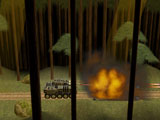
(Rolling Assault Game Screenshots)
It’s Judgment Play
One the big issues with physics-based game design is the issue of inertia. Naturally, any Newtonian physics engine that mimics reality will have such things as inertia, the conservation of angular momentum, and so on. But are those things necessarily conducive to a fun, responsive play experience? Not really. More often than not the limitations of reality actually get in the way.
Rolling Assault suffers in this regard. The control seemed fine in the early prototypes. It was satisfying to roll around; the wheels’ motion was aesthetically pleasing. However, as soon as we introduced very specific movement goals–dodge this missile, jump over this barrier–the sluggishness in the tank’s motion becomes apparent. The tank simply isn’t nimble enough to perform directed tasks without some degree of player frustration.
Solutions to Sluggishness
There are two obvious solutions to this problem. One is simply to remove high-fidelity movement requirements from the game’s design. This could be accomplished by putting more emphasis on accurate aiming and the game’s overall weaponry. The tank’s motion would change from a focal point to an abstracted means of scrolling the level forward. The player’s attention would instead be drawn to predictive aiming and observing enemy movement rather than the exact position of the tank. This would require completely rethinking enemy design.
Another solution is to tune the tank’s physics setup to be more responsive. One way to accomplish this is to exaggerate directional changes. For instance, if the tank is moving right and the player wants to go left, the game would provide additional impulses to overcome inertia. As soon as the tank is moving left properly, though, it would scale back the leftward impulses. This sort of anti-inertia logic is actually present in Amoeball and did help make the game feel more responsive. The complexity of the tank would require some additional tweaking–do you boost the torque of the wheels (which are already pretty slippery to begin with, since they are perfect spheres with infinitesimally small contact points)? Or do you fake it with impulses? Add torque on the main body so the player can arbitrarily control rotation mid-air? It would be an interesting design exercise, to say the least.
Play It! It’s Free!
All told, I’m pleased with how Rolling Assault came out. The game is well under a man-month of combined effort, and reasonably entertaining for how little time has been invested in it.
The one-level prototype of Rolling Assault is available exclusively at Fun-Motion. It’s a wee download, weighing in at 5 MB, and completely free. If you’ve read this far definitely check the game out. My rambling words can only do so much good without hands-on experience.
Download Rolling Assault physics game here (5 MB).
(there is no quit key, just alt-F4 when you’re done playing)
Related Posts:
- List of Physics Games
- Excellent Marble Madness-Inspired Physics Game
- Frustration Generator: Sprinky Physics Game
- Paint the Town with “De Blob” Physics Game
- Gish, The Father of Physics Platformers
A Chorus of Physics Games: Bounce Symphony
Bounce Symphony (aka Bounce aka Color Harmony) by Sprout Games was one of the first physics games aimed at the casual market. The game was released over the summer of 2003, back when Bookworm was a recent title and John Romero was trying his hand at making casual games with Congo Cube. Good times. The gameplay in Bounce Symphony is simple enough: click and drag colored balls to create horizontal lines of five or more.
Playing the Game
The limiting factor to enjoying Bounce Symphony is the inherent frustration in physically accomplishing your objective. In particular, trying to accomplish that goal with the mouse. It can be annoying to grab a tiny physics ball with the cursor. I use a mouse for hours a day, every day, and I still find it particularly irritating at times. The game would translate much more smoothly to something like the Nintendo DS or a PocketPC platform where you could interact with a stylus or, ideally, a multi-touch system like this bad boy. Grabbing and throwing things at a frantic pace with a mouse is simply too demanding, especially for a casual user.
Variations on a Theme
Thankfully, you can choose to play the game without time pressure. There are three modes presented: Relax, Sprint, and Think. Sprint and Relax are the same game mode but with without time pressure. Everyone except the most masochistic of players would probably enjoy playing without time pressure much more than they would with it.
Bounce Symphony introduces as many variations as possible as the game progresses to keep things fresh: score multipliers, bombs, blocks, super-heavy rocks, and so on. The developers have done a fair job with keeping things interesting, although the core interaction with the game remains the same which dampens long-term enjoyment.
The Think game mode is completely different. It’s a puzzle mode, of sorts, where you’re given a bunch of balls and a desired arrangement for those balls. Sometimes there is a trick to lining everything up, but more than anything this mode feels like busywork. Oftentimes it’s just plain obvious how to do it, but you end up spending most of your time trying to do things like a swap a ball on the bottom with one on the top.
Physics Game Design
Bounce Symphony didn’t do tremendously well in the market, from what I understand. It’s easy to play armchair game designer with these kinds of things, of course, and much harder to actually develop a fun game. Nonetheless, my two cents:
I think Sprout missed the mark at a very fundamental level. What’s fun about a physics game? Is it knocking stuff around? Smashing things? Setting up domino-style chain reactions? Or aligning objects with anal-retentive attention to detail? I think Bounce Symphony is fighting its physics game nature with its goal structures. At the very least, if accurate alignment is a goal the balls should be twice their size.
I would have liked to see Bounce Symphony explore other possible goals with their engine, and especially explore dynamic stages. As is, nothing moves by itself; player interaction is the only force that turns the static play field into something more interesting.


(Bounce Symphony Game Screenshots)
Untapped Potential
I have to wonder if the old Sprout team, now at PopCap, ever toys with the notion of revisiting the concept of a physics-based casual game. I think there’s a lot of mileage to be had here. Caramba Deluxe took a good stab it, but I’m surprised other developers don’t give it a go.
Bounce Symphony can be a relaxing distraction from a day’s work unless, of course, you work at a marble factory as a color quality control engineer. Then you should go shoot zombies or something with your gaming time.
Bounce Symphony can be downloaded for a free 60-minute trial from such places as Shockwave and RealArcade. The full version of the game is $20.
P.S. A Quick History Lesson
The original Bounce was developed by Escape Factory, a small retail console game developer. After they had canceled their primary project there was company downtime while they sniffed around for renewed funding. During this time they developed handful of small games, one of which was Bounce. Several months later the founders of Escape Factory created a new company specifically to develop casual titles: Sprout Games. Last summer, PopCap Games acquired Sprout (for what was undoubtedly several millions of dollars). All’s well that ends well, I guess.
Related Posts:
- List of Physics Games
- Portal, Valve’s New Physics-Based Puzzle Game
- Physics in Casual Games, Caramba Deluxe
- Ragdolls on a Pinball Table
- One-Part Tetris, One-Part Physics: Triptych



 (Rate this game! 65 votes, average: 3.46 out of 5)
(Rate this game! 65 votes, average: 3.46 out of 5)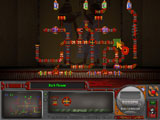
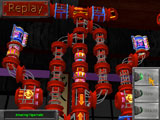
 My name is Matthew Wegner, and this site is dedicated to physics games.
My name is Matthew Wegner, and this site is dedicated to physics games.